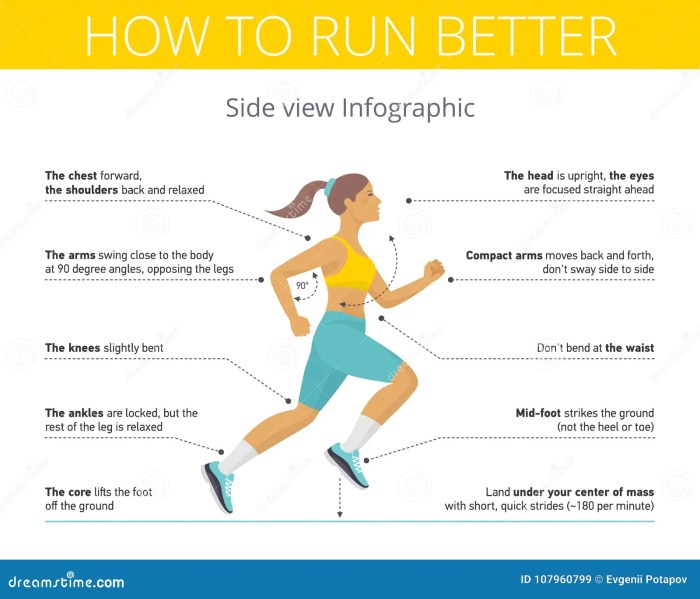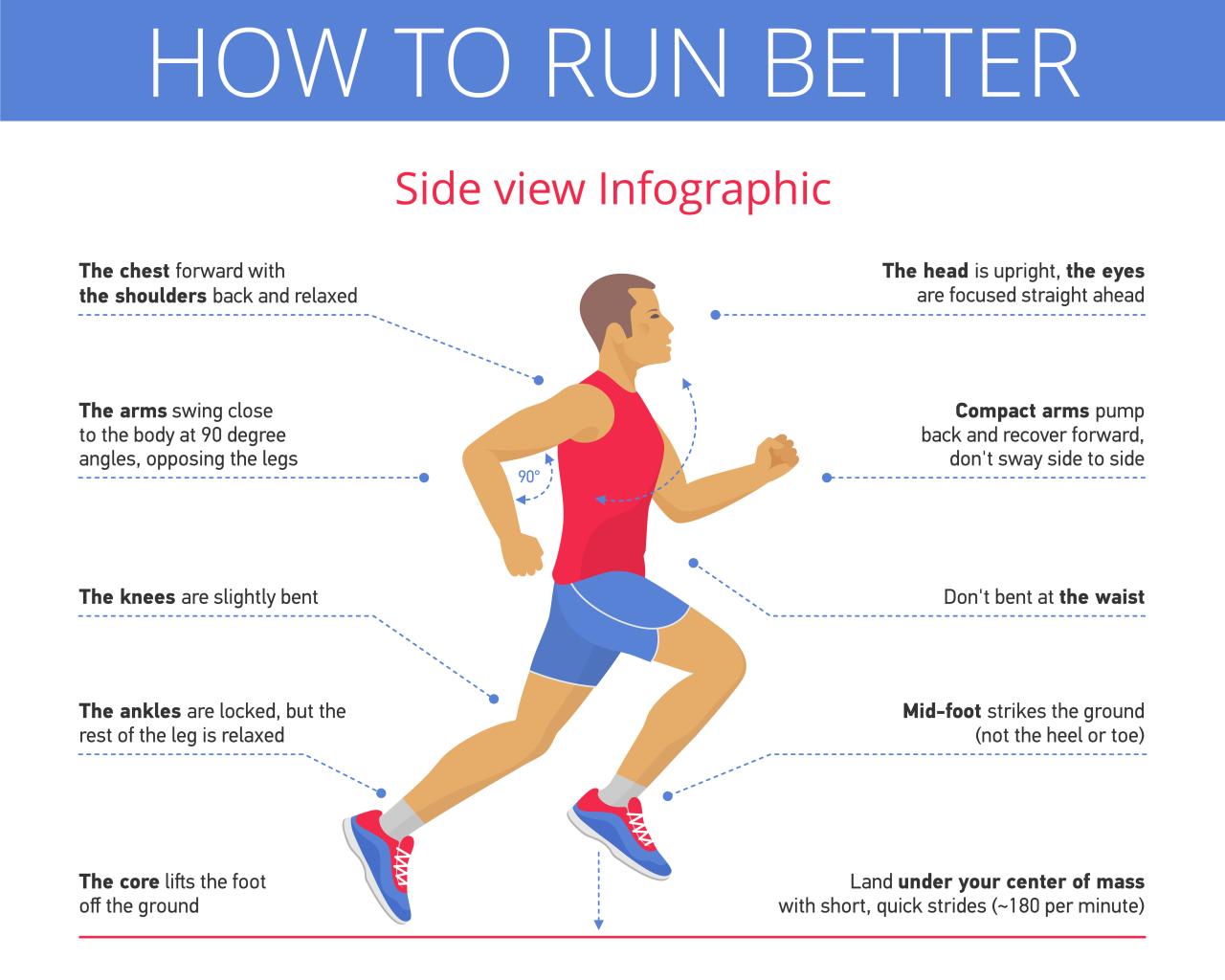Running techniques are key to success on the track. From sprinting to long-distance running, understanding the nuances of each form can make or break an athlete’s performance. Get ready to dive into the world of running techniques with us.
In this comprehensive guide, we will explore different running techniques, their impact on the body, and how to train effectively to improve your form. Whether you’re a seasoned runner or just starting out, this information will take your running game to the next level.
Running Techniques Overview
When it comes to running, athletes utilize a variety of techniques to enhance their performance and prevent injuries. Proper running techniques are crucial in maximizing efficiency and reducing the risk of strains or other issues. The way you run can vary depending on the type of running you are doing, whether it’s sprinting, long-distance running, trail running, or any other form of the sport.
Sprinting
- Sprinting involves explosive power and speed, requiring a more forward-leaning posture and pumping arms vigorously to propel yourself forward.
- Short, quick strides are essential in sprinting to maintain high speed and acceleration.
- Focus on driving your knees up and maintaining a strong core to generate power.
Long-Distance Running
- In long-distance running, endurance and pacing are key, so the focus is on maintaining a steady pace and conserving energy.
- Long, fluid strides with a slight forward lean help in covering more ground efficiently.
- Arm movement should be relaxed and in sync with your stride to maintain balance and momentum.
Trail Running
- Trail running requires agility and adaptability as you navigate various terrains and obstacles.
- Shorter, quicker strides are often necessary on uneven surfaces to maintain stability and prevent tripping.
- Use your arms for balance and leverage, especially when climbing or descending steep sections.
Common Running Techniques

When it comes to running, there are several common techniques that runners use to optimize their performance and reduce the risk of injuries. These techniques include forefoot striking, midfoot striking, and heel striking. Each of these techniques has its own impact on joints and muscles, as well as pros and cons for different types of runners.
Forefoot Striking
Forefoot striking is a running technique where the runner lands on the balls of their feet before rolling onto the toes. This technique helps to reduce the impact on the heels and lower legs, which can be beneficial for runners with a history of heel pain or shin splints. However, forefoot striking can put more strain on the calves and Achilles tendon, so it may not be suitable for everyone.
Midfoot Striking
Midfoot striking involves landing on the middle of the foot, distributing the impact more evenly across the foot compared to forefoot striking. This technique can help reduce the risk of injuries to the calves and Achilles tendon while providing good shock absorption. Midfoot striking is often recommended for runners looking for a balance between forefoot and heel striking.
Heel Striking, Running techniques
Heel striking is a common running technique where the runner lands on the heel of their foot first before rolling onto the toes. While this technique is less taxing on the calves and Achilles tendon, it can increase the impact on the knees and lower back. Heel striking is often preferred by beginners or runners with a tendency to overpronate.
Training for Proper Running Techniques
Proper training is essential for improving running techniques and preventing injuries. Here are some tips and exercises to help you enhance your form and performance.
Focus on Running Drills
- High knees: Lift your knees up high with each stride to improve your running form and strengthen your hip flexors.
- Butt kicks: Kick your heels up towards your glutes to increase your stride frequency and improve your leg turnover.
- Strides: Incorporate short bursts of faster running into your workout to improve speed and running efficiency.
Importance of Strength Training
Strength training plays a crucial role in improving running techniques by enhancing muscle power and endurance. Incorporate exercises like squats, lunges, and calf raises to strengthen your lower body and improve running performance.
Emphasize Flexibility
- Stretch regularly: Maintain flexibility in your muscles and joints to prevent injuries and improve running efficiency.
- Yoga or Pilates: Incorporate flexibility-focused workouts like yoga or Pilates to improve range of motion and overall running performance.
- Foam rolling: Use a foam roller to release muscle tension and improve flexibility, aiding in better running form.
Running Biomechanics

When it comes to running biomechanics, understanding the mechanics of how our body moves while running is crucial for improving performance and preventing injuries. Factors such as stride length, cadence, and foot strike play a significant role in determining how efficiently we run.
Stride Length
Stride length refers to the distance covered with each step while running. Finding the right balance between a too short or too long stride is essential for optimal running efficiency. A stride that is too short can lead to overstriding, causing braking forces that slow you down. On the other hand, a stride that is too long can lead to inefficient energy expenditure and increased risk of injury.
Cadence
Cadence is the number of steps taken per minute while running. It is often measured in steps per minute (SPM). Maintaining an optimal cadence can help improve running efficiency and reduce the risk of injuries. A higher cadence is generally associated with better running form and reduced impact forces on the body.
Foot Strike
Foot strike refers to the part of the foot that makes initial contact with the ground while running. There are three main types of foot strikes: heel strike, midfoot strike, and forefoot strike. Each type of foot strike has its pros and cons, and the optimal foot strike pattern varies from person to person. Finding the right foot strike can help improve running efficiency and reduce the risk of injuries.
Speed/Endurance Relationship
The relationship between running biomechanics and speed/endurance is complex. Efficient running biomechanics can help improve both speed and endurance by reducing energy wastage and minimizing the risk of injuries. Factors such as stride length, cadence, and foot strike can impact how fast you can run and how long you can sustain that pace. By optimizing your running biomechanics, you can enhance your overall running performance.

